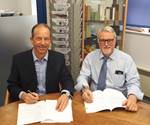KraussMaffei expands LFI and SCS processing with shuttle mold carrier
At the Munich-based TechCenter, the MX mold carrier is developed to improve fiber injection and spraying capabilities including for large, Class-A components.
KraussMaffei (Munich, Germany) announces the addition of a new shuttle mold carrier for long fiber injection (LFI) and structural component spraying (SCS) at its Munich-based TechCenter. The new MX mold carrier, acquired with the goal of advancing KraussMaffei’s capabilities in fiber-reinforced lightweight construction, has a clamping force of 4,000 kilonewtons, a flexible design and the ability to be combined with LFI or spraying applications. Surface technologies such as reinforced reaction injection molding (R-RIM) with polyurethane are also said to be possible.
“The market for fiber-reinforced composites continues to develop very dynamically. We support our customers sustainably from the idea to the serial production. That's why we are continuously modernizing and expanding our lightweight construction TechCenter and offering our customers optimal conditions for developing and testing new production-ready technologies and automation tasks,” says Sebastian Schmidhuber, head of development of reaction process machinery.
The new shuttle mold carrier is part of a complete system that has a separate cab and robot for LFI and SCS processes. Five mixing heads are available for various tests and automation tasks. An additional shuttle carrier is used to quickly transport the bottom mold between the machining stations of the bottom mold — for example, the foam discharge can occur in the bottom mold outside of the clamping unit. The series also features flexibility in the tilting movement in the upper and lower mold fixing platens.
Combining the shuttle mold carrier with LFI is said to enable a range of applications, from small trim parts for an automotive interior to large structural components with Class-A visible surfaces. Since mold cavity pressures are less than 10 bar, LFI can be used to produce a high-strength sandwich element with a honeycomb structure as the core layer. SCS, a development of LFI honeycomb technology, further reduces the thickness and the weight of the top layers, with the aim of optimizing lightweight construction. In SCS processes, layers composed of fiber mats and honeycomb cores are sprayed with unreinforced PUR, inserted into a mold, and pressed into shape.
The KraussMaffei TechCenter in Munich, Germany features more than 4,000 square meters of space and more than 25 systems, including injection molding, reaction processing machinery and extrusion technology that are available for internal tests and for customers to optimize their processes in practice or test prototypes.
Related Content
-
Pultrusion: The basics
A primer describing what pultrusion is, its advantages and disadvantages, and typical applications.
-
Sulapac introduces Sulapac Flow 1.7 to replace PLA, ABS and PP in FDM, FGF
Available as filament and granules for extrusion, new wood composite matches properties yet is compostable, eliminates microplastics and reduces carbon footprint.
-
The potential for thermoplastic composite nacelles
Collins Aerospace draws on global team, decades of experience to demonstrate large, curved AFP and welded structures for the next generation of aircraft.

.jpg;width=70;height=70;mode=crop)














